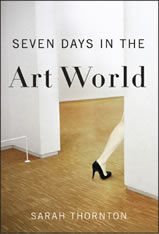
Seven Days in the Art World
by Sarah Thornton
Sarah Thornton’s Seven Days in the Art World could be called demystifying. And in some ways, it is. Thornton flits around the globe, dropping into seven spots that are generally velvet-roped off: behind the scenes at a Christie’s auction; at the awarding of the Turner Prize; inside a CalArts crit; observing the Artforum offices; peering into the studios of Takashi Murakami; and touring Art Basel and the Venice Biennale.
But Thornton upholds the glamour of the art world as much as she exposes its workings. For all the times her interviewees compare dealing and collecting in the contemporary art market with whoring, there are as many instances in which they treat art as their religion. Thornton may describe minutely the negotiations of a particular dealer, but she also grants a respectful privacy when anyone refuses a question (her generous written treatment of their refusals are quite distinct from the curt phrases of a journalist). It is sacred and profane, secret and exposed, and Thornton balances those qualities.
Her prose is comfortable and easy-going compared to the hectic pace of the “days” she writes. Big names in the art world float across the pages. John Baldessari appears in three chapters like “God – a hippie version of Michelangelo’s representation of the grand old man in the Sistine Chapel.” The owners of L.A.’s Blum & Poe gallery, characterized as Californians through and through (with the requisite comparison to Jeff Bridges’ The Dude), chat with Thornton in Switzerland and Japan.
Amy Cappellazzo of Christie’s is “refreshingly unpretentious” in her insights, noting, for instance, that people are unlikely to buy a brown painting before a red one, or a sad painting rather than a happy one, or a male nude over a female nude. Moments of elucidation like these are several in Thornton’s book. She charts what auctions, a major prize, or an Artforum cover do for an artist’s sales. She explains the trends in MFA instruction and observes the inner workings of a major artist’s studio (and the negotiations held therein) in preparation for a big show. She offers a who’s who of dealers and collectors.
The artists Thornton interviews are sometimes cagey, like 2006 Turner Prize winner Tomma Abts, but most are refreshingly open and low-key. Thorton quotes English artist Phil Collins for example as saying he feels like Carrie in the eponymous film when he’s nominated for the Turner Prize. Ed Ruscha says he is “terrible at hanging works” and needs help from the “smart ladies,” curators Linda Norden and Donna De Salvo. Murakami is self-deprecating about his management skills. Rebecca Warren, responding to a less-than-flattering story about her work after she was nominated for the Turner, said, “Once you’ve got in the Daily Star, you just think, this is brilliant.”
For a book about the art world, which could have focused entirely on deals, there is a fair amount of discussion of actual art, notably Thornton’s own taste for a Sophie Calle self-portrait. And while dealers, collectors, and many others in Thornton’s conversations can’t quite explain how they know a good piece beyond some gut reaction, one scene in particular best captures that response, that indefinable, unteachable appeal: At Art Basel, Thornton notices a seven or eight-year-old girl peering at her reflection in Jeff Koons’s Elephant. She “stops in her tracks, and sticks out her tongue. She frowns. She gnashes her teeth, flares her nostrils, moves her eyebrows up and down, then skips off to catch up with her parents.”
Excerpt: “I find myself upstairs with a good view of the Barbara Gladstone stand. A collector once told me, ‘Barbara is one of my compass points. There is north, south, east, and Barbara.’ At Art Basel, the Gladstone booth is in the front row facing the courtyard, an aggressive location appropriate to a gallery that has been in operation since 1980 and sits on top of the ruthless ranks of the New York art world. Gladstone herself has jet-black hair and is dressed entirely in black Prada. One wouldn’t imagine that this sophisticated sorceress was once upon a time a Long Island housewife who taught art history part-time at the local university – until she disarms you with her down-home charm.”
Further Reading: The 2 Million Stuffed Shark: The Curious Economics of Contemporary Art and Lives of the Artists




Send A Letter To the Editors